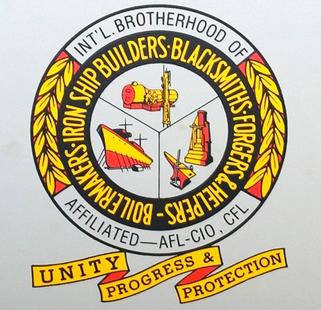

On this day in Labor History the year was 1893.
That was the day that the International Brotherhood of Boilermakers and Iron Ship Makers of America was founded in Chicago.
This joined two earlier boilermaker unions into one.
They decided to establish their headquarters in Kansas City, Kansas.
Two years later, the Boilermakers affiliated with the American Federation of Labor.
The union represents members of 250 lodges in the United States and Canada.
At the turn of the twentieth century, the Boilermakers had about 8,500 members.
But the membership expanded, especially during World War II, as shipbuilding grew for the war.
By 1944, there were more than 350,000 Boilermakers.
In 1954, they merged with the International Brotherhood of Blacksmiths, Drop Forgers and Helpers, and expanded their name to include these groups of workers.
But what exactly is a boilermaker?
According to the union’s website the term can have many meanings.
It might refer to a Purdue University student or alumni, whose football team started going by the name of the boilermakers in 1891.
Or boilermaker might refer to dropping a shot of whiskey into a draft of beer, and drinking it all at once.
But for the labor movement a boilermaker is someone that constructs and repairs boilers, and the other workers who are part of the union.
These might include “blacksmiths, forgers, ship builders, cement workers, stove workers, metal polishers, or numerous other job descriptions.”
The boilermaker’s union logo reflects these workers.
It includes images of a ship, a worker working on a boiler, and a blacksmith’s anvil.
Below the images are found the words “Unity, Progress and Protection” declaring the mission of the union and its members.
More Episodes
All Episodes>>You may also like
Create Your Podcast In Minutes
- Full-featured podcast site
- Unlimited storage and bandwidth
- Comprehensive podcast stats
- Distribute to Apple Podcasts, Spotify, and more
- Make money with your podcast











